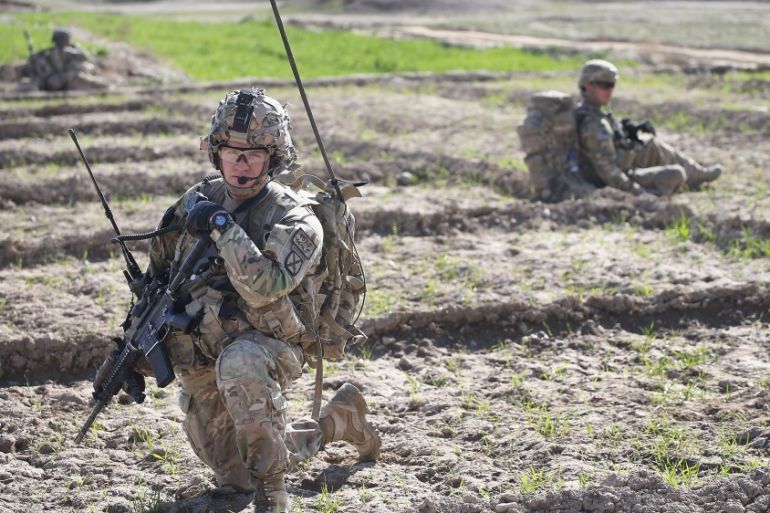Timeline: US intervention in Afghanistan 2001 to 2017
Key developments of a 16-year conflict, from the 2001 US invasion after 9/11 to Trump’s latest strategy reveal.

After more than 15 years of US troops presence in Afghanistan, President Donald Trump unveiled on Monday a new strategy for the country and cleared the way to send thousands more US troops there.
Currently, 8,400 American soldiers are taking part in NATO’s operation in Afghanistan, which comprises a total of 13,000 troops in all. Most of them are charged with overseeing and training Afghan forces.
Keep reading
list of 4 items‘Catch and kill’ scheme takes centre stage at Trump hush-money trial
‘Battlelines’ drawn as jury hears opening remarks in Trump hush money case
Trump’s defence makes opening statement in ‘hush money’ trial
Below are developments in the US military presence in the country.
2001: ‘War on terror‘
On October 7, 2001, less than a month after the September 11 attacks, US President George W Bush launches operation “Enduring Freedom” in Afghanistan, after the Taliban refuses to hand over al-Qaeda leader Osama bin Laden.
In a matter of weeks, the US-led forces overthrow the Taliban, in power since 1996.
Apart from air raids, the US backs the Afghan Northern Alliance, which is fighting the Taliban, contributing paramilitary teams from the CIA and special forces.
Some 1,000 American soldiers are deployed on the ground in November, rising to 10,000 the year after.
2003-2008: Taliban regroups, Bush sends more troops
Attention is diverted from Afghanistan as US forces in 2003 mount an invasion of Iraq, which becomes the main US concern.
The Taliban and other armed groups regroup in their strongholds in the south and east of Afghanistan, from where they can easily travel to and from Pakistani tribal areas.
In 2008, the American command on the ground calls for manpower to carry out an effective strategy against the Taliban. Bush agrees to send additional soldiers and by mid-2008 there are 48,500 US troops there.
2009: Number of soldiers peaks under Obama
In 2009, in the first months of the presidency of Barack Obama – elected on campaign promises to end the two wars in Iraq and Afghanistan – there is a surge in the number of American soldiers in Afghanistan to around 68,000.
In December, Obama raises the strength of US forces in Afghanistan to around 100,000. The objective, the US says, is to put brakes on the Taliban and to strengthen Afghan institutions.
2011: Bin Laden killed in Pakistan
Al-Qaeda leader Bin Laden, alleged mastermind of the 9/11 attacks that started the war, is killed on May 2, 2011 during an operation by US special forces in Pakistan, where he is in hiding.
2014: End of combat operations
In September 2014, Afghanistan signs a bilateral security accord with the US and a similar text with NATO: 12,500 foreign soldiers, of which 9,800 are Americans, will remain in the country in 2015, after the end of the NATO combat mission at the end of 2014.
From the beginning of 2015, American troops will be charged with two missions: “anti-terrorist” operations against al-Qaeda and training Afghan forces.
In late December, the NATO combat mission ends, and is replaced by an assistance mission baptised “Resolute Support”.
However, the security situation degenerates.
Amid a resurgent Taliban, on July 6, 2016, Obama again slows down the pace of withdrawal, saying that 8,400 US troops will remain in Afghanistan into 2017.
2015: US bombs MSF clinic
On October 3, 2015, at the height of combat between armed groups and the Afghan army, backed by NATO special forces, a US air raid bombs a hospital run by Medecins Sans Frontiers (Doctors Without Borders) in northern Kunduz province, killing 42, including 24 patients and 14 members of the NGO.
April, 2017: ‘MOAB’ – Mega bomb against ISIL
On April 13, 2017, the US military drops the largest non-nuclear bomb it has ever used in combat, hitting the Islamic State of Iraq and the Levant (ISIL, also known as ISIS) group positions in a network of tunnels and caves in the east, killing 96 fighters.
In July, the American army kills the ISIL’s new leader in Afghanistan, the third such chief slain by Washington and Kabul.
Feb – August, 2017: New strategy
On February 1, 2017, a US government report says that losses of Afghan security forces have climbed by 35 percent in 2016 compared with the previous year.
On February 9, the US general in command of the NATO force, General John Nicholson, warns that he needs thousands more troops, telling Congress: “I believe we’re in a stalemate.”
On August 21, Trump cleared the way for the deployment of thousands more US troops to Afghanistan in his first formal address to the nation as commander-in-chief.
Following the president’s speech, US Defense Secretary James Mattis announced that America and several allies have committed to boosting their troop numbers in Afghanistan.
Senior White House officials say Trump has already authorised Mattis to deploy up to 3,900 more troops to Afghanistan.